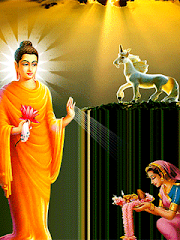Buddhist symbology
Gautama Buddha has a central place in Buddhism and therefor too in Buddhist art. Still it took a few centuries after the Buddha's Paranirvana before the Buddha was pictured in Buddhist art in the form that we've become accustomed to: meditating for instance. It was only around the start of the Common Era that the image of the Buddha became normal in Buddhist art.
Aniconic Buddha
The first Buddhist artists showed the Buddha aniconically: he wasn't shown as a person, but represented by symbols. Common symbols were an umbrella, a set of footprints, the wheel and a throne. Below pictures which use these symbols from early Buddhist art.
The tree that is shown here a couple of times is the tree at Bodh Gaya where Buddha reached enlightenment: the Bodhi Tree. At this pilgrimage site a throne was later created. This throne is often shown on pictures that otherwise seem meant to show the moment of Enlightenment.
Most of the pictures below show artwork from the Bharhut stupa in central India.
Throne near the Bodhi BoomThe throne at Bodh Gaya is worshiped here. In this case what's shown is probably not so much the moment of enlightenment, as the pilgrimage to the Bodhi Tree. Railing pillar, Bharhut.; Stone: Sandstone; India, Sunga Period, 2nd-1st century BC ; Now at Calcutta, India: Indian Museum; Digibeeld nr. 13900. railing pillar ; medallion ; worship of tree ; worship of throne ; Kanakamuni Buddha ; Bharhut | |
Umbrella / ParasolThe parasol is one of the oldest symbols of the Buddha and is seen as representing his royal birth. In this case three umbrella's are shown, instead of one. This picture is from the Amaravati stupa in South India and was probably made slightly after the start of the Common Era. Other symbols used include the footprints and the empty throne. Source found nov. 16th 2006 Amaravati stupa, built over 1800 years ago in Northern India, this panel is now in the British Museum. You can see four people bowing. What are they bowing to? The symbols that we can see in this picture are: | |
Feet imprintsThe footprints of the Buddha are a strange Buddhist symbol, as the Buddha was thought to float above the ground. That's how divine people thought he was. Despite that he left a foot print here and there, which is seen as a sign of his presence, a kind of blessing. In this case both the throne and the footprints (to the right) are worshiped. Ajatasatru railing pillar from Bharhut.; Stone; India, Sunga Period, 2nd-1st century BC ; Now at Calcutta, India: Indian Museum. Digibeeld nr. 13746. | |
WheelThe wheel symbolizes both the Buddhist teachings (Dharma), Buddha's first sermon at the deerpark at Benares and in this case the Buddha himself. King Prasenajit is visiting the Buddha in this scene from the Bharhut Stupa railing. Scene: King Prasenajit Visits the Buddha. Prasenajit railing pillar, Bharhut.; Stone: Sandstone; India, Sunga Period, 2nd-1st century BC ; Now at Calcutta, India: Indian Museum; Digibeeld nr. 13720. |
Footnote
The pictures used above are from the archives of the Kern Institute, Leiden University, unless otherwise noted. The text accompanying is based on the digital database from the university. The pictures have been slightly changed for this online article.


.gif)




ไม่มีความคิดเห็น:
แสดงความคิดเห็น